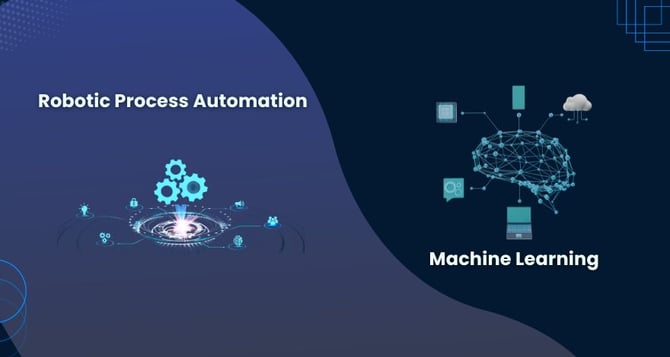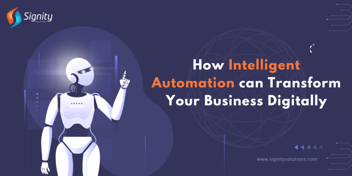Robotic Process Automation Vs. Machine Learning
State-of-the-art technologies like Robotic Process Automation and Machine Learning lead to hyper-automation. Separately, they give a hand to achieve specific automation goals. But what is the difference between them? And what truly makes them unique? Read the article to learn more about RPA and ML and their distinctions.

Step into the concept of business automation, and you will find yourself among several technologies vying for attention. The ongoing debate between Robotic Process Automation (RPA) against Machine Learning (ML) is not new and dominates the dynamic landscape.
Many businesses have embraced RPA functions to automate mundane and repetitive duties. However, they occasionally require additional abilities. Enter machine learning, and the outcome is "intelligent automation," which, unlike the former, can learn and adjust.
A survey highlights almost 74% of business leaders could meet their goals better if they invest more in machine learning and automation. Why is it so?
Read this article to learn in-depth about RPA and ML and explore their notable differences to determine which one your business needs.
Let's Delve Into the Concept of Robotic Process Automation
As the name suggests, Robotic Process Automation implies employing specialized robots or bots – essentially pre-programmed algorithms – to streamline business operations. These bots simulate human action and blend the efficiency of machines with human-like behavior.
Robotic Process Automation (RPA) emerged as a fledgling tool in the early 2000s. It leveraged established technologies like screen scraping and workflow automation to help organizations. However, RPA has evolved into the primary automation solution across various sectors.
The RPA market has grown to around $4 billion and will exceed $13 billion by 2030. The reports estimate that Robotic Process Automation will generate approximately $22.5 billion by 2025.
A survey claims that RPA will achieve “near universal adoption” in the upcoming five years.
See it this way, Imagine a world where robots are the ultimate office interns and diligently handle data entry, copy-pasting, report generation, calculations, and even extracting information from emails. That is a part of what RPA can do for your business!
What Advantages Does Robotic Process Automation Offer?
Robotic Process Automation continues to garner attention from organizations for various reasons. Around 98% of IT leaders believe automating business processes is essential for driving benefits.
Some of the primary RPA benefits are:
1. Enhanced Accuracy
Humans can get distracted and make mistakes. It is normal, but it can cost a lot when you have a business to run. A well-implemented RPA with high-quality data sources harbors zero margins of error. About 85% of businesses report that RPA met their expectations for benefits.
2. Increased Productivity
RPA bots focus on performing specific routine tasks. For instance, if your employee takes 3 hours to complete a report, RPA will allow the same employee to finish it in 15 minutes. Implementing Robotic Process Automation will thus undoubtedly save time and costs and accelerate productivity.
3. Scalability Opportunities
Your responsibilities expand with your business. However, the lack of flexibility can make it challenging to meet incoming demands. You can leverage RPA tools to automate any routine task the expansion requires. Further, it can support numerous functions to help you achieve business objectives.
4. Improved Customer Service
Meeting customers' demands is challenging, especially when they tend to fluctuate. A minor mishap is enough to break their trust in you and turn toward your competitors.
Open-source RPA can help you understand and address customer queries and respond quickly. It will also give your employees time to attend to complex customer issues.
Use Cases of Robotic Process Automation in Business
About 10% to 20% of work hours go into completing dull and repetitive tasks. Consequently, businesses lose around 50% of automation opportunities on average. Robotic Process Automation (RPA) helps address the gap and offers innovative solutions across various domains.
Here are some uses of Robotic Process Automation in business:
1. Customer Service
You can automate approximately 70% to 80% of tasks, and customer service can be an excellent way to start! RPA can automate repetitive tasks like order processing and ticket routing to streamline customer service. It enhances response times and improves the overall customer experience.
Related Read: RPA in Customer Service
2. Invoice Processing
RPA can extract data from invoices, validate it against predefined rules, and enter the information into relevant systems. You can use it to speed up the invoicing process, minimize errors, and maintain accurate financial records.
3. Finance
RPA in finance can help you with account reconciliation, data entry, and report generation, among other tasks. It facilitates accurate and timely financial data, reduces manual effort, and supports compliance with financial regulations.
4. Recruitment
Several RPA tools can assist in handling resume screening, initial candidate communication, and scheduling interviews. You can employ it to accelerate the hiring process, alleviate HR personnel for more strategic activities, and ensure a consistent candidate experience.
What is Machine Learning?
Machine Learning is a subset of popular Artificial Intelligence. It uses algorithms to perform a specific task without being explicitly programmed. It recognizes patterns in the data and makes predictions based on its learnings once the new data arrives.
There are three types of ML algorithms:
-
Supervised Learning
It employs labelled data to train the algorithm to identify patterns and facilitate predictions based on new and unlabeled data.
-
Unsupervised Learning
Unsupervised Learning uses unlabeled data to recognize patterns and relationships within the data.
-
Reinforcement Learning
It utilizes a reward-based system to train the algorithm to make decisions based on maximizing the rewards.
Machine Learning is an effective method for automating intricate tasks that extend beyond rule-based automation. It has gained significant traction due to its implementation in various industries. The Machine Learning industry is worth $31.01 billion at present. It is estimated to reach $276.58 billion by 2027.
What are the Benefits of Machine Learning?
Machine Learning transforms data into valuable insights, automates tasks, wows customers, and turns operations into a breeze. Here are the notable perks Machine Learning accompanies:
1. Process Automation
Machine Learning steps in as the ultimate efficiency tool and automates complex tasks that may require human intervention. It can learn patterns from historical data and apply them to make decisions or perform actions.
2. Enhanced Customer Experience
ML has a knack for reading between the lines of customer interactions. It analyzes sentiments, preferences, and behavior and helps you personalize experiences. It provides tailored recommendations and even predicts customer needs.
3. Operation Efficiency Growth
Machine Learning optimizes supply chains, predicts maintenance needs for machinery, and maintains production schedules. It works like a team of data-savvy consultants who optimize processes to perfection.
4. Decision-Making
ML brings data-driven decisions to the forefront. It can analyze vast amounts of information, spot trends, and make predictions that human brains might miss. It leads to more informed and accurate decision-making across various fields.
What are the Use Cases of Machine Learning in Business?
Machine Learning has provided businesses with benefits reaching from $250,000 to $20 million. It spans various applications, platforms, and departments. You can seamlessly integrate into existing IT frameworks without extensive new installations. Some of its use cases include:
1. Recommendations
You can use it to analyze data and behaviors of the customers and make personalized product or content recommendations. It will help enhance customer experience and drive sales.
2. Fraud Detection
Machine learning can give you a hand in identifying unusual transactional or behavioral patterns. It will allow you to detect and prevent fraudulent activities and protect both customers and the business.
3. Chatbots
Machine Learning powers chatbots to handle customer inquiries, provide support, and guide users through purchasing processes. It can significantly respond to queries and improve customer service efficiency.
4. Learning Apps
Companies in the education sector can utilize machine learning in applications to customize lessons and track student progress. It can provide adaptive content and enhance the effectiveness of online education offerings.
Robotic Process Automation Vs. Machine Learning: Key Differences
While RPA and ML both give a hand in automation and elevate operational efficiency, their functionality, purpose, and the required human intervention level mark a significant contrast. Given below are the distinctions between Robotic Process Automation and Machine Learning:
1. Scalability and Adaptability
Robotic Process Automation can automate repetitive tasks within established rules. For instance, you can leverage it to copy data from emails to spreadsheets and streamline data entry processes. However, RPA might require manual intervention when faced with dynamic circumstances.
Machine Learning (ML) may prove more beneficial to adjust to new data formats or sources. It autonomously learns from new data and is suitable for predicting product demand based on historical sales data.
|
Aspect |
Robotic Process Automation |
Machine Learning |
|
Scalability |
Limited scalability for complex tasks |
Scalable for dealing with diverse data |
|
Adaptability |
Limited adaptability to changes |
Can adapt to new contexts and conditions |
|
Suitability |
Better for structured processes |
Suited for data-driven tasks |
RPA uses predefined rules and instructions to automate repetitive tasks. However, it may face challenges with complex tasks requiring constant updates. Machine Learning, however, can adapt to new data and situations. However, it requires substantial computing power and specialized hardware.
2. Level of Human Intervention Required
RPA often demands human involvement to set up and handle exceptions. It can handle routine customer queries but may require human oversight for complex inquiries.
On the other hand, you can train ML systems to categorize and prioritize customer emails and reduce manual sorting. It will soon become adept at identifying nuanced patterns and handling diverse queries.
|
Aspect |
Robotic Process Automation |
Machine Learning |
|
Human Involvement |
High human involvement in the setup |
Comparatively less human intervention |
|
Automation Level |
Relatively static data |
Evolves with data and learning |
|
Decision Complexity |
Follows predetermined rules |
Can make complex decisions |
Robotic Process Automation requires well-defined rules and human input to establish automation processes. Machine Language aims to learn from data and minimize human intervention. However, it demands human intervention for preparing data, selecting models, and tuning.
3. Technological Differences
Robotic Process Automation relies on predefined scripts and specific steps to interact with interfaces. It uses a Graphical User Interface (GUI) to communicate with applications and websites. However, the RPA system will require modifications when you change the interface or add a new field.
In contrast, ML algorithms can analyze text data from customer reviews to extract sentiments without relying on predetermined rules. Its flexibility allows it to adapt to variations in data sources and formats.
|
Aspect |
Robotic Process Automation |
Machine Learning |
|
Interaction Medium |
Interfaces with GUI elements |
Analyzes and processes data |
|
Integration |
Easily integrate and implement with legacy systems |
Need for a significant amount of data preparation and model training |
|
Problem-Solving |
Manages repetitive tasks |
Handles data-driven problems |
Robotic Process Automation relies on scripts or macros to interact with graphical user interfaces. While Machine Learning involves training algorithms on data to identify patterns and make predictions.
4. Functionality and Purpose
RPA excels in automating structured tasks by following predefined rules and workflows. For example, It can extract and enter data into an accounting system to automate invoice processing.
Machine Language can analyze customer behavior on an e-commerce platform to recommend products. It enables ML to adapt to evolving customer preferences and offer tailored recommendations based on changing data patterns.
|
Aspect |
Robotic Process Automation |
Machine Learning |
|
Main Purpose |
Automates routine tasks |
Analyzes data and makes predictions |
|
Task Complexity |
Works with structured processes |
Handles data analysis and patterns |
|
Output |
Repetitive task automation |
Insights, predictions, and classifications |
Robotic Process Automation streamlines manual tasks and reduces human effort. Meanwhile, Machine Learning focuses on data analysis, pattern recognition, and decision-making for predictions and insights.
5. Required Expertise
RPA and ML necessitate different areas of expertise for viable implementation. You will need experts who understand their invoicing process to define accurate automation rules when automating invoice processing with RPA.
On the contrary, consulting data scientists is better for analyzing user behaviors and creating a recommendation system for your customers based on intricate user preferences.
|
Aspect |
Robotic Process Automation |
Machine Learning |
|
Skill Set |
Process automation expertise |
Data science and ML engineering |
|
Knowledge Base |
Proficient in business rule understanding |
In-depth data analysis |
|
Development Approach |
Leans on predefined task rules |
Data modeling and algorithm design |
Robotic Process Automation and Machine Language are robust technologies you can leverage to revolutionize your business. From healthcare to finance to retail, both unlock endless possibilities. However, you must consider the complexity and accuracy your project requires to pick the ideal solution.
Many certified organizations offer RPA consulting services, they guide you from strategy to deployment, ensuring efficient automation.
The bottom line is that RPA and ML come with their fair share of limitations and benefits. But you can use them together to enhance efficiency and the quality of data-driven decisions. You can employ the strengths of each to foster innovation and achieve business objectives with greater speed.














